
Slovenia is situated at the crossroads of central and southeast Europe, touching the Alps and bordering the Adriatic Sea. The Alps—including the Julian Alps, the Kamnik–Savinja Alps and the Karawank chain, as well as the Pohorje massif—dominate northern Slovenia along its long border to Austria. Slovenia's Adriatic coastline stretches approximately 47 km (29 mi) from Italy to Croatia. Its part south of Sava river belongs to Balkan peninsula – Balkans.

Northeast Italy is one of the five official statistical regions of Italy used by the National Institute of Statistics (ISTAT), a first level NUTS region and a European Parliament constituency. Northeast encompasses four of the country's 20 regions:

The economy of the European Union is the joint economy of the member states of the European Union (EU). It is the second largest economy in the world in nominal terms, after the United States, and the third largest at purchasing power parity (PPP), after China and the US. The European Union's GDP is estimated to be $19.35 trillion (nominal) in 2024 or $26.64 trillion (PPP), representing around one-sixth of the global economy. Germany has the biggest national GDP of all EU countries, followed by France and Italy. In 2022, the social welfare expenditure of the European Union (EU) as a whole was 19.5% of its GDP.

Western Transdanubia is a statistical region of Hungary. It is part of the Transdanubia region. Western Transdanubia includes the counties of Zala, Vas, and Győr-Moson-Sopron.
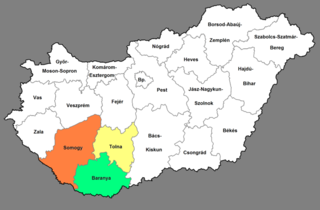
Southern Transdanubia is a statistical region of Hungary. It is part of the Transdanubia region. Southern Transdanubia includes the counties of Somogy, Tolna, and Baranya. Its capital and largest city is Pécs. It borders Croatia to the south, the Southern Great Plain NUTS 2 region to the east, the Central Transdanubia NUTS 2 region to the north, and the Western Transdanubia NUTS 2 region to the north-west.

Yuzhen Tsentralen Planning Region is a Bulgarian planning region. The capital is Plovdiv, the second-largest city in Bulgaria. It includes five Bulgarians provinces: Plovdiv Province, Pazardzhik Province, Smolyan Province, Kardzhali Province and Haskovo Province.

Severen Tsentralen Planning Region is a planning region of Bulgaria, encompassing five Bulgarian provinces: Ruse, Veliko Tarnovo, Gabrovo, Targovishte and Razgrad.
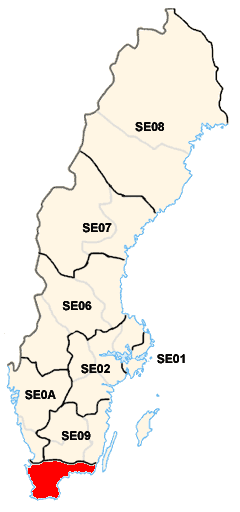
South Sweden is a national area of Sweden. The national areas are a part of the NUTS statistical regions of Sweden.

The statistical regions of Slovenia are 12 administrative entities created in 2000 for legal and statistical purposes.

Eastern Slovenia is one of the two NUTS-2 Regions of Slovenia. The region forms the eastern part of the country and includes the cities of Maribor, Celje, Velenje and Novo Mesto. It is the less wealthy of the two regions of Slovenia.
Sidi Haneish Airfield is an abandoned World War II military airfield complex in Egypt, in the western desert, about 376 km west-northwest of Cairo.

The Upper Carniola Statistical Region is a statistical region in northwest Slovenia. It is a region with high mountains, including Mount Triglav, and is almost entirely Alpine. A large part of this statistical region is protected as a national park. The relief and climate are good bases for tourism. In 2013, the region recorded almost 19% of tourist nights in Slovenia, of which 78% were by foreign tourists. The region ranked second in Slovenia in number of tourist beds per 1,000 population, even though it had just over half as many beds as the Coastal–Karst Statistical Region. In 2013, the registered unemployment rate here was the lowest in Slovenia, 3 percentage points lower than the national average and more than 8 percentage points lower than in the Mura Statistical Region, where the registered unemployment rate was the highest. Although agriculture in this region is not among the most important activities, the farms are among the largest in the country both in terms of average utilised agricultural area per farm and in terms of the number of livestock per farm.

The Gorizia Statistical Region is a statistical region in western Slovenia, along the border with Italy. It is named after the Italian town of Gorizia.
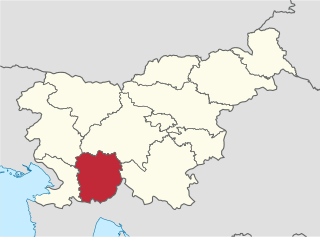
The Littoral–Inner Carniola Statistical Region is a statistical region in southwest Slovenia. Until January 1, 2015 it was named the Inner Carniola–Karst Statistical Region.
In the NUTS codes of Slovenia (SI), the three levels are:

The Central Sava Statistical Region is a statistical region in Slovenia. This statistical region in the Sava Hills is the smallest region in the country in terms of both area and population. In early-2010 almost 41,700 people lived on 264 km2, meaning that together with the Central Slovenia Statistical Region it is the most densely populated statistical region. The natural and geographic features of this region create conditions for industrial activities and more than a third of gross value added is still generated by manufacturing, mining, and other industry. In 2013, the region once again recorded the highest negative annual population growth rate (−11.9‰), which was mainly a result of migration to other statistical regions. Among all statistical regions in 2013, this region had the highest negative net migration between regions; namely, −9.5. This region also stands out by age of mothers at childbirth. In 2013 first-time mothers in the region were on average 28.5 years old, whereas first-time mothers in the Central Slovenia Statistical Region were on average 1 year older. In the same year, the number of unemployed persons increased further. The registered unemployment rate was among the highest in the country (16.6%). In comparison with other regions, this is 7 percentage points more than in the region with the lowest registered unemployment rate, Upper Carniola, and almost 1 percentage point less than in the region with the highest unemployment rate, the Mura Statistical Region. According to the labour migration index, this is the most residential statistical region. In 2013, 60% of people in the region worked in their region of residence, and 40% worked in another region.

The Lake Geneva region, Lemanic Region or Region Lémanique is the common name of the region of Switzerland encompassing the cantons of Geneva, Vaud and Valais. It is one of the NUTS-2 regions of Switzerland.
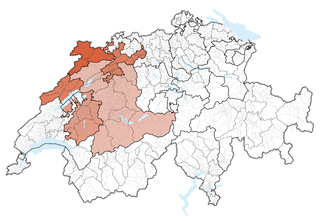
Espace Mittelland is a region of Switzerland, encompassing the cantons of Bern, Fribourg, Jura, Neuchâtel and Solothurn. It is one of the NUTS-2 regions of Switzerland.
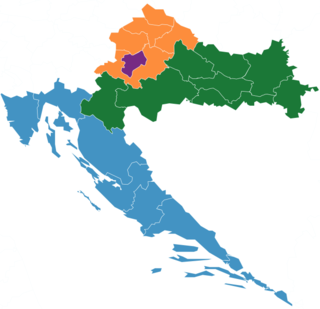
Northern Croatia or North Croatia refers to the northern parts of Croatia, encompassing Zagreb, Varaždin, Međimurje, Zagorje and Koprivnica-Križevci counties, including the cities of Zagreb, Varaždin, Čakovec, Krapina, Koprivnica and Križevci. The region is home to the Kajkavian dialect, which some consider to be a separate language of its own. The region borders Hungary to its north-east and Slovenia to its north-west.

Western Slovakia is one of the four NUTS-2 Regions of Slovakia. It was created at the same time as were the Nitra, Trnava and Trenčín regions. Western Slovakia is the most populated of the four regions of Slovakia and its GDP per capita is 69% of the European Union average.


















